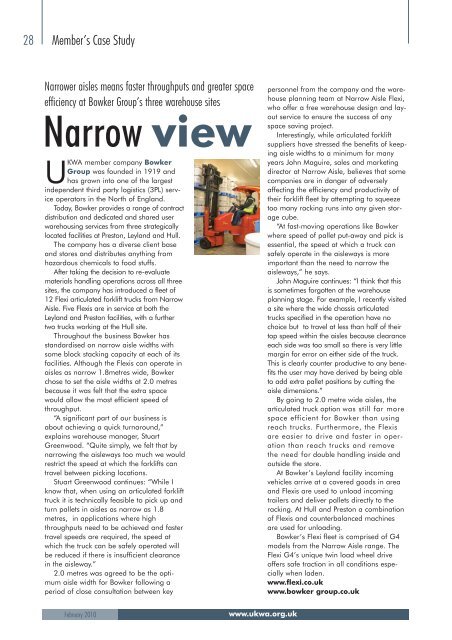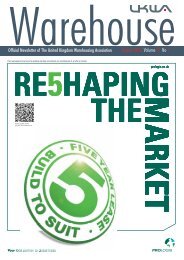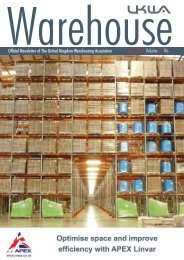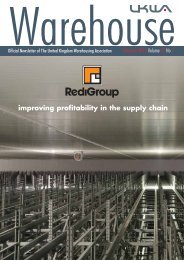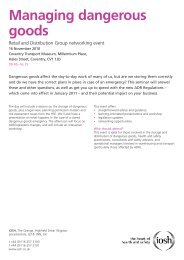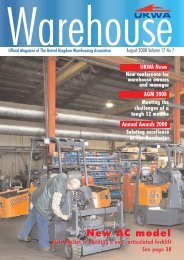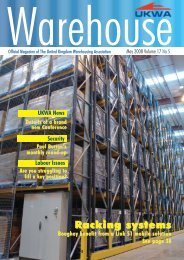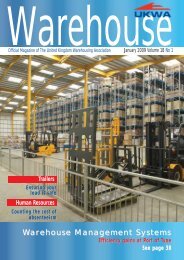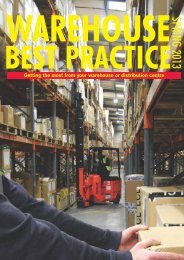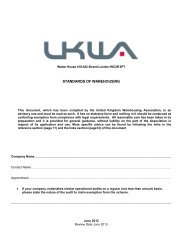ukwa 2 cover - United Kingdom Warehousing Association
ukwa 2 cover - United Kingdom Warehousing Association
ukwa 2 cover - United Kingdom Warehousing Association
- No tags were found...
Create successful ePaper yourself
Turn your PDF publications into a flip-book with our unique Google optimized e-Paper software.
28 Member’s Case Study<br />
Narrower aisles means faster throughputs and greater space<br />
efficiency at Bowker Group’s three warehouse sites<br />
Narrow view<br />
UKWA member company Bowker<br />
Group was founded in 1919 and<br />
has grown into one of the largest<br />
independent third party logistics (3PL) service<br />
operators in the North of England.<br />
Today, Bowker provides a range of contract<br />
distribution and dedicated and shared user<br />
warehousing services from three strategically<br />
located facilities at Preston, Leyland and Hull.<br />
The company has a diverse client base<br />
and stores and distributes anything from<br />
hazardous chemicals to food stuffs.<br />
After taking the decision to re-evaluate<br />
materials handling operations across all three<br />
sites, the company has introduced a fleet of<br />
12 Flexi articulated forklift trucks from Narrow<br />
Aisle. Five Flexis are in service at both the<br />
Leyland and Preston facilities, with a further<br />
two trucks working at the Hull site.<br />
Throughout the business Bowker has<br />
standardised on narrow aisle widths with<br />
some block stacking capacity at each of its<br />
facilities. Although the Flexis can operate in<br />
aisles as narrow 1.8metres wide, Bowker<br />
chose to set the aisle widths at 2.0 metres<br />
because it was felt that the extra space<br />
would allow the most efficient speed of<br />
throughput.<br />
“A significant part of our business is<br />
about achieving a quick turnaround,”<br />
explains warehouse manager, Stuart<br />
Greenwood. “Quite simply, we felt that by<br />
narrowing the aisleways too much we would<br />
restrict the speed at which the forklifts can<br />
travel between picking locations.<br />
Stuart Greenwood continues: “While I<br />
know that, when using an articulated forklift<br />
truck it is technically feasible to pick up and<br />
turn pallets in aisles as narrow as 1.8<br />
metres, in applications where high<br />
throughputs need to be achieved and faster<br />
travel speeds are required, the speed at<br />
which the truck can be safely operated will<br />
be reduced if there is insufficient clearance<br />
in the aisleway.”<br />
2.0 metres was agreed to be the optimum<br />
aisle width for Bowker following a<br />
period of close consultation between key<br />
personnel from the company and the warehouse<br />
planning team at Narrow Aisle Flexi,<br />
who offer a free warehouse design and layout<br />
service to ensure the success of any<br />
space saving project.<br />
Interestingly, while articulated forklift<br />
suppliers have stressed the benefits of keeping<br />
aisle widths to a minimum for many<br />
years John Maguire, sales and marketing<br />
director at Narrow Aisle, believes that some<br />
companies are in danger of adversely<br />
affecting the efficiency and productivity of<br />
their forklift fleet by attempting to squeeze<br />
too many racking runs into any given storage<br />
cube.<br />
“At fast-moving operations like Bowker<br />
where speed of pallet put-away and pick is<br />
essential, the speed at which a truck can<br />
safely operate in the aisleways is more<br />
important than the need to narrow the<br />
aisleways,” he says.<br />
John Maguire continues: “I think that this<br />
is sometimes forgotten at the warehouse<br />
planning stage. For example, I recently visited<br />
a site where the wide chassis articulated<br />
trucks specified in the operation have no<br />
choice but to travel at less than half of their<br />
top speed within the aisles because clearance<br />
each side was too small so there is very little<br />
margin for error on either side of the truck.<br />
This is clearly counter productive to any benefits<br />
the user may have derived by being able<br />
to add extra pallet positions by cutting the<br />
aisle dimensions.”<br />
By going to 2.0 metre wide aisles, the<br />
articulated truck option was still far more<br />
space efficient for Bowker than using<br />
reach trucks. Furthermore, the Flexis<br />
are easier to drive and faster in operation<br />
than reach trucks and remove<br />
the need for double handling inside and<br />
outside the store.<br />
At Bowker’s Leyland facility incoming<br />
vehicles arrive at a <strong>cover</strong>ed goods in area<br />
and Flexis are used to unload incoming<br />
trailers and deliver pallets directly to the<br />
racking. At Hull and Preston a combination<br />
of Flexis and counterbalanced machines<br />
are used for unloading.<br />
Bowker’s Flexi fleet is comprised of G4<br />
models from the Narrow Aisle range. The<br />
Flexi G4’s unique twin load wheel drive<br />
offers safe traction in all conditions especially<br />
when laden.<br />
www.flexi.co.uk<br />
www.bowker group.co.uk<br />
February 2010<br />
www.<strong>ukwa</strong>.org.uk


